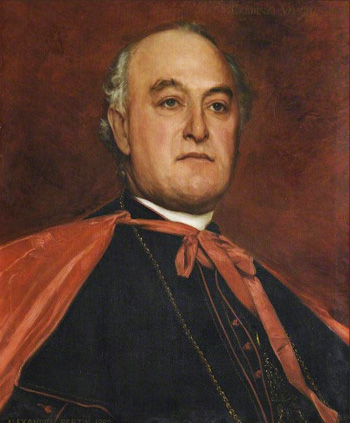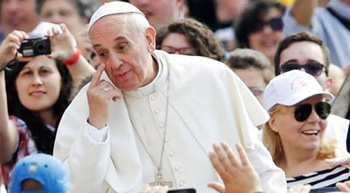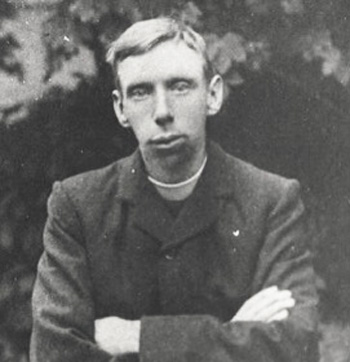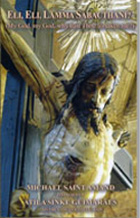Traditionalist Issues
 |
 |
 |
 |
 |
 |
 |
Dialogue Mass - CXXIV
The ‘Listening Church’
The reason for all this confusion is that the lines between the Ecclesia Docens (the teaching Church) – represented by the Hierarchy – and the Ecclesia Discens (the learning Church) – represented by the faithful – have been deliberately blurred to inculcate a new paradigm into the minds of the faithful – the “Listening Church.”
Denying this distinction was one of the chief concerns of the early Modernists, and Fr. Tyrrell openly denied that any such distinction existed among the first Christians:
“At the beginning there was not a teaching Church and a learning Church, but a teaching Church and a learning world. … Every Christian in virtue of his baptism was a teacher and apostle. And to each and all of these apostles he communicates his own authority; his own Spirit; his own mission: ‘Receive the Holy Spirit; as the Father hath sent me so send I you.’”(1)
 He took up the cudgels shortly after Card. Herbert Vaughan, Archbishop of Westminster – in whose Diocese he lived – issued his Joint Pastoral Letter (2) of January 29, 1900, signed by the Bishops of England and Wales. It is important to know that Card. Vaughan’s initiative was a courageous attempt to combat the growing threat of Liberal Catholicism, which favored the emancipation of the laity from the authority of the Hierarchy. Without mentioning Tyrrell by name, the Cardinal reprimanded those who “substitute the principle of private judgment for the principle of obedience to religious authority,” and who try “to persuade the people that they are the ultimate judge of what is true and proper in conduct and religion.”
He took up the cudgels shortly after Card. Herbert Vaughan, Archbishop of Westminster – in whose Diocese he lived – issued his Joint Pastoral Letter (2) of January 29, 1900, signed by the Bishops of England and Wales. It is important to know that Card. Vaughan’s initiative was a courageous attempt to combat the growing threat of Liberal Catholicism, which favored the emancipation of the laity from the authority of the Hierarchy. Without mentioning Tyrrell by name, the Cardinal reprimanded those who “substitute the principle of private judgment for the principle of obedience to religious authority,” and who try “to persuade the people that they are the ultimate judge of what is true and proper in conduct and religion.”
Most galling for Fr. Tyrrell and his fellow Modernists was the Cardinal’s reminder that “the doctrines of the faith … have been entrusted, as a Divine deposit, to the teaching Church, and to her alone,”(3) and that the faithful must accept the doctrine and interpretation of Scripture handed down by Tradition on the authority of the Hierarchy.
But Fr. Tyrrell, in one of his typically irrational outbursts – he once adopted the nickname “furia irlandaise” (4) – could not contain his irascible temper, flew into a rage and rejected this teaching out of hand. In a letter of March 2, 1901, signed “A Conservative Catholic,” which he sent to a newspaper called The Pilot, he criticized the Pastoral Letter severely, accusing it of potentially causing grave harm to the Church. Without supplying any rational arguments, he fulminated:
“It would cleave the Church into two bodies, the one all active, the other all passive, related literally as sheep and shepherds ‒ as beings of a different order with conflicting interests; it would destroy the organic unity of the Church by putting the Pope (or the Ecclesia Docens) outside and over the Church, not a part of her, but her partner, spouse, and Lord, in a sense proper to Christ alone; it would shear the bishops of their inherent prerogatives while restoring to them a tenfold power as the delegates and plenipotentiaries of the infallible and unlimited authority claimed for the Pope.” (5)
The whole passage is riddled with non sequiturs, hyperbole and militancy against the real meaning of the Church as the one, indivisible Body of Christ, Head and members, composed of Shepherds and sheep, as Pope Pius X, in keeping with Tradition, had explained.
Tyrrell’s view – that the two-tier system of the Constitution shattered the essential unity of the Church – is unsustainable. It foreshadowed the same narrative adopted and repeated by post-Vatican II progressivists who are influenced by the Council’s exaltation of the laity to a “prophetic” status in the Church. The corollary of this novel position is that the Hierarchy must listen to and accept the insights of lay people supposedly inspired by the Holy Ghost to reveal new doctrines to the Church.
The heresy of ‘vital immanence’
Lay people, claimed Pope Francis, possess “an instinctive ability to discern the new ways that the Lord is revealing to the Church.”(6) This is one of the many occasions when Francis reveals himself as a master of duplicitous speech that exploited ambiguities of language to give the impression of being true in some sense, but also conveniently capable of being misread in another.
 If we take the word “revealing,” the implication is that Revelation is ongoing and discernable by means of changing, subjective feelings of the Christian community – a key tenet of Modernism. But the Church had always taught that Revelation had ended with the last of the Apostles; so the “new ways” supposedly revealed by God and intuited by the laity are not part of any “universal consensus” received by the Church from the beginning, and are therefore not covered by infallibility. Rather, the novel teaching is reminiscent of the heresy of “vital immanence” – which posits that knowledge of the truth originates and develops from human experience – espoused by Fr. Tyrrell and the early Modernists.
If we take the word “revealing,” the implication is that Revelation is ongoing and discernable by means of changing, subjective feelings of the Christian community – a key tenet of Modernism. But the Church had always taught that Revelation had ended with the last of the Apostles; so the “new ways” supposedly revealed by God and intuited by the laity are not part of any “universal consensus” received by the Church from the beginning, and are therefore not covered by infallibility. Rather, the novel teaching is reminiscent of the heresy of “vital immanence” – which posits that knowledge of the truth originates and develops from human experience – espoused by Fr. Tyrrell and the early Modernists.
The evidence shows that Pope Francis is simply echoing the idea of the “general consensus” proposed by Fr. Tyrrell who put it this way:
“God’s highest and fullest manifestation is given, not in the clouds, or in the stars, but in the spirit of man, and therefore most completely in that completest expression of man’s spirit which is obtained in the widest available consensus, and is the fruit of the widest collective experience of the deepest collective reflection.” (7)
Is not this the very essence of Pope Francis’s “Synodal Way,” which is based on a garnering of all the “faith experiences” of the people? It is certainly in line with Tyrrell’s by-passing and rejection of the Ecclesia Docens:
 “The true Teacher of the Church is the Holy Spirit, acting immediately in and through the whole body of the faithful ‒ lay and cleric; the teaching of the episcopate consists in dispensing; in gathering from all and distributing to each, with the authority, and in name of the whole Divine Society.”
“The true Teacher of the Church is the Holy Spirit, acting immediately in and through the whole body of the faithful ‒ lay and cleric; the teaching of the episcopate consists in dispensing; in gathering from all and distributing to each, with the authority, and in name of the whole Divine Society.”
Fr. Tyrrell’s apostasy (and that of his Vatican II followers) is evident from his rejection of orthodox teaching on Christ as the Founder and formal principle of the Church:
“What Christ founded was not the hierarchic Church but the little body of missionary brethren, which subsequently, under the guidance of Christ’s Spirit, organised itself into the Catholic Church; that He did not directly commission some of them to teach and rule over the rest; but commissioned all of them equally to go and teach all nations.” (9)
It would be impossible to deny the close parallel that exists between Fr. Tyrrell’s teaching and the current insistence on the “co-responsibility of the People of God” for the governance of the Church, itself derived from Vatican II.
Pope Francis, who was always uncomfortable with the hierarchical structure of the Church and her teaching authority, expressed similar sentiments in his pre-Synodal address when he complained about “a certain resistance to moving beyond the image of a Church rigidly divided into leaders and followers, those who teach and those who are taught.” To reinforce his belief that this constitutional arrangement was not willed by God, he added:
“We forget that God likes to overturn things: As Mary said, ‘he has thrown down the rulers from their thrones but lifted up the lowly’ (Lk 1:52).” (10)
Reading between the lines, we can see how the Pope has twisted this scriptural quotation to justify “inverting the pyramid,” leading the “lowly” faithful to believe that Christ the King (represented by the Pope at the apex) would be cast down from His throne, never more to rule over them.
At least, this explains why Pope Francis, instead of fulfilling his principal role of confirming the brethren in the Faith and teaching sound moral doctrine, sees his mission in “Synodal” (“Collegial”) terms, as that of confirming the corporate “faith experiences” of all the baptized ‒ always, of course, excluding those of a traditionalist persuasion. That, apparently, is his idea of how to serve the People of God.
As for Fr. Tyrrell, who was one of the earliest promoters of these ideas in the Church, we must keep in mind that he was a member of an organization called the Synthetic Society which existed between 1896 and 1910; it was co-founded by Wilfrid Ward (Catholic Editor of the Dublin Review and biographer of Card. Newman) to find a new synthesis among all religions. According to Tyrrell’s main biographer, Maude Petre, Ward introduced Tyrrell to the Synthetic Society in 1899. (11)
The conclusion is inescapable that, by adopting the same ideological outlook as George Tyrrell, Pope Francis is trying to achieve a synthetic one-world religion through “a universal consensus in matters of faith and morals” based on heterodox beliefs, as per Amoris laetitia, for example. As this situation could only have come about by suspending the role of the Ecclesia Docens, the post-Conciliar Church finds itself estranged from Tradition, insofar as it is no longer eager to preserve and defend the Catholic Faith by the divinely-ordained means at its disposal.
Continued
Denying this distinction was one of the chief concerns of the early Modernists, and Fr. Tyrrell openly denied that any such distinction existed among the first Christians:
“At the beginning there was not a teaching Church and a learning Church, but a teaching Church and a learning world. … Every Christian in virtue of his baptism was a teacher and apostle. And to each and all of these apostles he communicates his own authority; his own Spirit; his own mission: ‘Receive the Holy Spirit; as the Father hath sent me so send I you.’”(1)

Card. Herbet Vaughan
Most galling for Fr. Tyrrell and his fellow Modernists was the Cardinal’s reminder that “the doctrines of the faith … have been entrusted, as a Divine deposit, to the teaching Church, and to her alone,”(3) and that the faithful must accept the doctrine and interpretation of Scripture handed down by Tradition on the authority of the Hierarchy.
But Fr. Tyrrell, in one of his typically irrational outbursts – he once adopted the nickname “furia irlandaise” (4) – could not contain his irascible temper, flew into a rage and rejected this teaching out of hand. In a letter of March 2, 1901, signed “A Conservative Catholic,” which he sent to a newspaper called The Pilot, he criticized the Pastoral Letter severely, accusing it of potentially causing grave harm to the Church. Without supplying any rational arguments, he fulminated:
“It would cleave the Church into two bodies, the one all active, the other all passive, related literally as sheep and shepherds ‒ as beings of a different order with conflicting interests; it would destroy the organic unity of the Church by putting the Pope (or the Ecclesia Docens) outside and over the Church, not a part of her, but her partner, spouse, and Lord, in a sense proper to Christ alone; it would shear the bishops of their inherent prerogatives while restoring to them a tenfold power as the delegates and plenipotentiaries of the infallible and unlimited authority claimed for the Pope.” (5)
The whole passage is riddled with non sequiturs, hyperbole and militancy against the real meaning of the Church as the one, indivisible Body of Christ, Head and members, composed of Shepherds and sheep, as Pope Pius X, in keeping with Tradition, had explained.
Tyrrell’s view – that the two-tier system of the Constitution shattered the essential unity of the Church – is unsustainable. It foreshadowed the same narrative adopted and repeated by post-Vatican II progressivists who are influenced by the Council’s exaltation of the laity to a “prophetic” status in the Church. The corollary of this novel position is that the Hierarchy must listen to and accept the insights of lay people supposedly inspired by the Holy Ghost to reveal new doctrines to the Church.
The heresy of ‘vital immanence’
Lay people, claimed Pope Francis, possess “an instinctive ability to discern the new ways that the Lord is revealing to the Church.”(6) This is one of the many occasions when Francis reveals himself as a master of duplicitous speech that exploited ambiguities of language to give the impression of being true in some sense, but also conveniently capable of being misread in another.

Watching the people to know what the Lord is revealing to the Chuch...
The evidence shows that Pope Francis is simply echoing the idea of the “general consensus” proposed by Fr. Tyrrell who put it this way:
“God’s highest and fullest manifestation is given, not in the clouds, or in the stars, but in the spirit of man, and therefore most completely in that completest expression of man’s spirit which is obtained in the widest available consensus, and is the fruit of the widest collective experience of the deepest collective reflection.” (7)
Is not this the very essence of Pope Francis’s “Synodal Way,” which is based on a garnering of all the “faith experiences” of the people? It is certainly in line with Tyrrell’s by-passing and rejection of the Ecclesia Docens:

Fr. George Tyrrell, S.J.
Fr. Tyrrell’s apostasy (and that of his Vatican II followers) is evident from his rejection of orthodox teaching on Christ as the Founder and formal principle of the Church:
“What Christ founded was not the hierarchic Church but the little body of missionary brethren, which subsequently, under the guidance of Christ’s Spirit, organised itself into the Catholic Church; that He did not directly commission some of them to teach and rule over the rest; but commissioned all of them equally to go and teach all nations.” (9)
It would be impossible to deny the close parallel that exists between Fr. Tyrrell’s teaching and the current insistence on the “co-responsibility of the People of God” for the governance of the Church, itself derived from Vatican II.
Pope Francis, who was always uncomfortable with the hierarchical structure of the Church and her teaching authority, expressed similar sentiments in his pre-Synodal address when he complained about “a certain resistance to moving beyond the image of a Church rigidly divided into leaders and followers, those who teach and those who are taught.” To reinforce his belief that this constitutional arrangement was not willed by God, he added:
“We forget that God likes to overturn things: As Mary said, ‘he has thrown down the rulers from their thrones but lifted up the lowly’ (Lk 1:52).” (10)
Reading between the lines, we can see how the Pope has twisted this scriptural quotation to justify “inverting the pyramid,” leading the “lowly” faithful to believe that Christ the King (represented by the Pope at the apex) would be cast down from His throne, never more to rule over them.
At least, this explains why Pope Francis, instead of fulfilling his principal role of confirming the brethren in the Faith and teaching sound moral doctrine, sees his mission in “Synodal” (“Collegial”) terms, as that of confirming the corporate “faith experiences” of all the baptized ‒ always, of course, excluding those of a traditionalist persuasion. That, apparently, is his idea of how to serve the People of God.
As for Fr. Tyrrell, who was one of the earliest promoters of these ideas in the Church, we must keep in mind that he was a member of an organization called the Synthetic Society which existed between 1896 and 1910; it was co-founded by Wilfrid Ward (Catholic Editor of the Dublin Review and biographer of Card. Newman) to find a new synthesis among all religions. According to Tyrrell’s main biographer, Maude Petre, Ward introduced Tyrrell to the Synthetic Society in 1899. (11)
The conclusion is inescapable that, by adopting the same ideological outlook as George Tyrrell, Pope Francis is trying to achieve a synthetic one-world religion through “a universal consensus in matters of faith and morals” based on heterodox beliefs, as per Amoris laetitia, for example. As this situation could only have come about by suspending the role of the Ecclesia Docens, the post-Conciliar Church finds itself estranged from Tradition, insofar as it is no longer eager to preserve and defend the Catholic Faith by the divinely-ordained means at its disposal.
Continued
- George Tyrrell, Medievalism, a Reply to Cardinal Mercier, London: Longmans, Green, and Co., 1908, p. 62-63.
- The Bishops of England and Wales, A Joint Pastoral Letter on the Church and Liberal Catholicism, The Tablet, January 5, 1901.
- In the aftermath of the modernist crisis, Pope Pius XII reiterated the same teaching: “This deposit of faith our Divine Redeemer has given for authentic interpretation not to each of the faithful, not even to theologians, but only to the Teaching Authority of the Church”. (Humani generis, August 12, 1950, § 21)
- “Irish Fury” – a pseudonym with which he signed a letter to his fellow Jesuit and modernist, Henri Bremond, after he was dismissed from the Jesuit Order. Apud Nicholas Sagovsky, On God’s Side: A Life of George Tyrrell, Oxford University Press, 1993, p. 203.
- G. Tyrrell and Maude Petre, George Tyrrell’s Letters, New York: E.P. Dutton, 1920, p. 154.
- Pope Francis, Address on the 50th anniversary of the institution of the Synod of Bishops, October 17, 2015.
- G. Tyrrell, Through Scylla and Charybdis, p. 355.
- G. Tyrrell, The Church and the Future, London: Priory Press, 1910, p. 101, (privately printed 1903).
- G. Tyrrell, Medievalism, pp. 138-139.
- On September 18, 2021, Pope Francis addressed about 1000 representatives from the Diocese of Rome on the subject of the upcoming International Synod.
- G. Tyrrell and Maude Petre, Autobiography and life of George Tyrrell, London: E. Arnold, vol. 2, 1912, p. 98.
Posted March 6, 2023
______________________
______________________
 Volume I |
 Volume II |
 Volume III |
 Volume IV |
 Volume V |
 Volume VI |
 Volume VII |
 Volume VIII |
 Volume IX |
 Volume X |
 Volume XI |
 Special Edition |